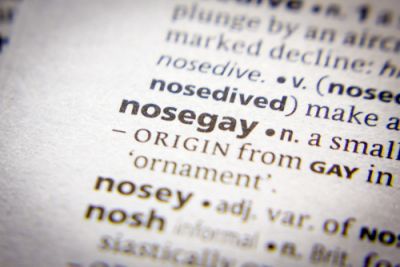 As you plan your wedding, you may catch yourself using certain words and phrases. You tell friends and family that you’re “tying the knot.” Together, you and your partner craft your ideal “honeymoon.” Your florist wants to talk about “nosegays” and your “tablescape.” Whether they’re familiar sayings or brand new slang, many of these expressions have fascinating origins.
As you plan your wedding, you may catch yourself using certain words and phrases. You tell friends and family that you’re “tying the knot.” Together, you and your partner craft your ideal “honeymoon.” Your florist wants to talk about “nosegays” and your “tablescape.” Whether they’re familiar sayings or brand new slang, many of these expressions have fascinating origins.
The Elusive Origins of “Tying the Knot”
Sources disagree about how the phrase “tying the knot” originated. Writing Explained claims it was first used in the 1500s and comes from the phrase “to tie a knot with one’s tongue that one cannot untie with one’s teeth.” English scholar John Ray included this expression in his 1670 book “A compleat collection of English proverbs.” At that time, it implied that marriage was a permanent bond.
Grammarist contends that “tying the knot” dates to around the 12th century, if not earlier. Did it refer to a custom of tying couples together during their wedding ceremonies? You may think of handfasting, but historian Sharon Krossa suggests that it’s a modern tradition. A Brides article mentions the saptapadi wedding ritual in which couples tie their garments together. But “tying the knot” comes from English, not Hindi. For now, its roots remain a bit of a mystery.
Putting the “Honey” in Honeymoon
After their wedding, many couples venture on magical getaways to far-flung destinations. Others travel closer to home or choose staycations for some well-earned rest. Regardless of the destinations or activities, they go on these honeymoons to relax, celebrate, and enjoy each other’s company.
“Honeymoon” may seem like a mystical word, but its roots are more down to earth than you may think. The Online Etymology Dictionary traces it to the 1540s when it first appeared as “hony moone.” OED’s cross-references expose both words’ Middle English roots, but Dictionary.com digs a little deeper. The term refers to an older European custom of giving mead to newlyweds. Mead is a sweet alcoholic drink created by fermenting honey and water with yeast, with some versions adding fruit, spices, and grains for flavor. Each couple received a large supply, intended to keep them happy for an entire month.
The Language of Flowers
Navigating the world of floristry can be a challenge, especially during wedding planning. It's one thing to figure out what you want, but decoding the language is quite another. What in tarnation are “nosegays” anyway? And what does your florist mean by a “tablescape”?
Believe it or not, the origins of “nosegay” are pretty straightforward. Merriam-Webster explains that Middle English speakers first joined “nose” and “gay” in the 15th century. At that time, “gay” meant something bright or ornamental. It’s rumored that they masked body odor during medieval times, but historians haven’t confirmed this. We do know that they were popular during the Victorian era, as the Encyclopedia Britannica reveals. Fashionable ladies carried these flower-and-herb mixtures, inserting them into silver filigree holders. They also transmitted messages between admirers using the “language of flowers.”
“Tablescapes” is a similar word, but it comes from modern times. Martha Stewart Weddings includes it in an updated list of wedding planning lingo. A simple portmanteau of “table” and “landscape,” it can refer to a table arrangement or centerpiece. Florists typically use it to describe a table décor scheme that incorporates multiple elements.
Words and Their Complex Stories
Language is only one component of communication. Yet it plays a critical part in conveying our thoughts. We use so many words and phrases in our everyday lexicons, not pausing to consider their origins. They reflect the culture and era from which they came, often in deeper ways than we realize. You can uncover their stories with a little digging, and these tales can enrich your wedding planning experience.
Add Your Comment